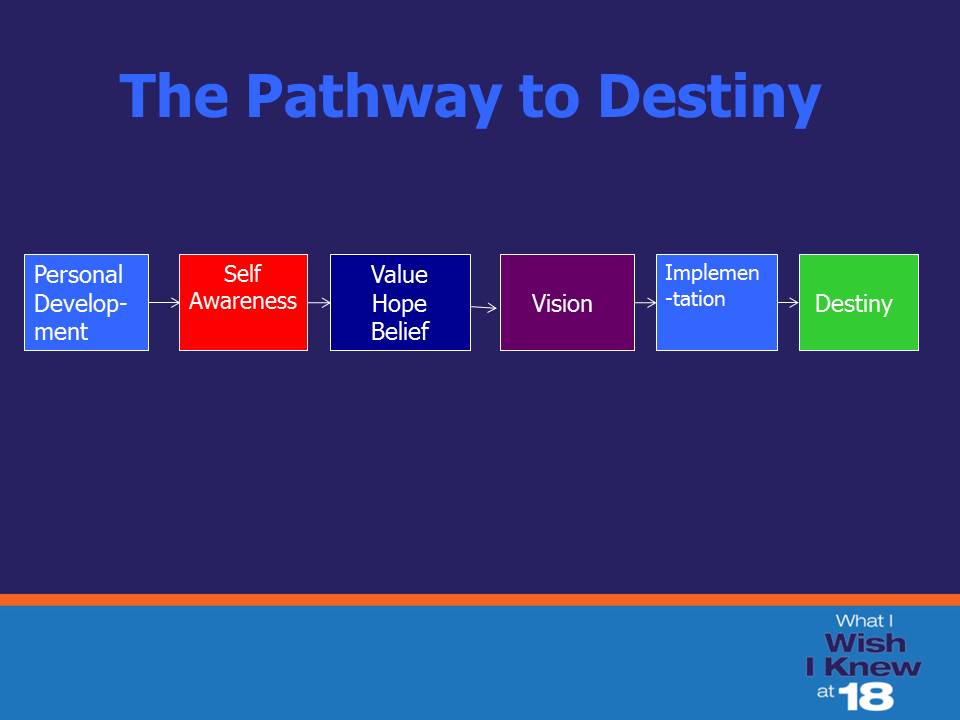Connect! (Part 3): Why Hope Matters
4/17/2016 11:43:41 PM
 What does it take to “succeed” in life? This is a question we often ask not only for ourselves, but also for the young adults in our life whom we want to see thrive, succeed, and achieve their destiny.
What does it take to “succeed” in life? This is a question we often ask not only for ourselves, but also for the young adults in our life whom we want to see thrive, succeed, and achieve their destiny.In our work with teens, educators, and parents, we’ve developed a helpful diagram that illustrates the path that most of us travel throughout life on the road to accomplishing our goals and “life purpose” (aka “destiny”).
You can see it starts off with our personal development, which combines our education, experiences, and nurturing. Next, comes a healthy self-awareness (i.e., Who am I? What do I have to offer? What are my passions and interests?) The invaluable outgrowth of these two steps is a sense of value, hope, and belief in ourselves and our future. Buoyed by these three steps, we can now develop a positive vision for our lives that, through daily implementation, determines our DESTINY.
More often than not, as parents or educators, we tend to jump in at the “vision” or implementation stages when we want to motivate teens (i.e., “You can be whatever you want to be,” or “Study hard; clean your room; stay out of trouble!”). But, when there’s not been enough time spent on the preceding stages, the child may “check out” at the Value, Hope, and Belief step—which makes it exceedingly difficult to impart vision or teach implementation skills. All too often, they drop out of high school or become involved in high risk behavior and groups to find a sense of belonging. Bottom line, when kids don’t feel valued, they lose hope—and may miss out on reaching their full potential as a result. Their destiny is compromised.
Research and experience inform us that the best way to build value in people of all ages is to connect with them—to affirm, relate, and encourage in a relational way. So, how can we do this with our children and/or students, and particularly if our relationships are strained?
For one thing, we have to get to know them as individuals. A good relationship between any two people rests on the platform of mutual respect and valuing the other’s unique gifts and contributions. Each person has characteristics that make him or her special and that set him/her up for a unique destiny. Teens vary remarkably in their needs, reactions, communications, and behavioral styles. This impacts how they respond and relate to the world around them. As famous football commentator and coach Tony Dungy wisely said, “It’s hard to lead someone you don’t know.” This is just as true in educating (or raising) teens as it is in coaching football players!
That’s where connection comes in—and with it, value, hope, and progress toward a successful future. Connection leads to understanding, which can help you:
- identify what motivates (and discourages) them
- appreciate their strengths and be empathetic toward their challenges
- communicate in such a way that they receive your messages in the manner intended
- respond to them in such a way that they feel safe, heard, and understood
- have realistic expectations of them
- respect differences
- develop strategies that work best for all of you
Ultimately, when we connect with our kids and students, we foster a sense of hope and expectation they need to thrive. Hope has the power to buffer people from stress, anxiety, and the effects of negative life events. More than that, neuroscience tells us that hope actually changes brain chemistry! Hope motivates learning and enables kids to move forward to their destiny, and to absorb and apply the valuable lessons and skills they need along the way.
Bottom line, the next time there’s a challenge with a student or a child, take a step back. Consider the Pathway to Destiny and see if you can identify where that child has the greatest need right now. Is it really for a pep talk or a how-to lesson? Or is there perhaps a need to back up a few steps, to focus on the foundations, to communicate, relate, and connect? When we do, we plant HOPE—which has exponential power to propel kids forward on the path to their destiny.
This was Part 3 in a series on Social Emotional Learning; visit our blog archive to see Part 1 and Part 2. Also, check out LifeSmart’s What I Wish I Knew at 18 resources for developing life skills, college and workplace readiness, and a strong personal leadership foundation in high school and middle school students. Conversationally written, and designed to impart life wisdom and practical skills in a relational context, our resources will help you make social emotional learning a vital part of your classroom or home environment.